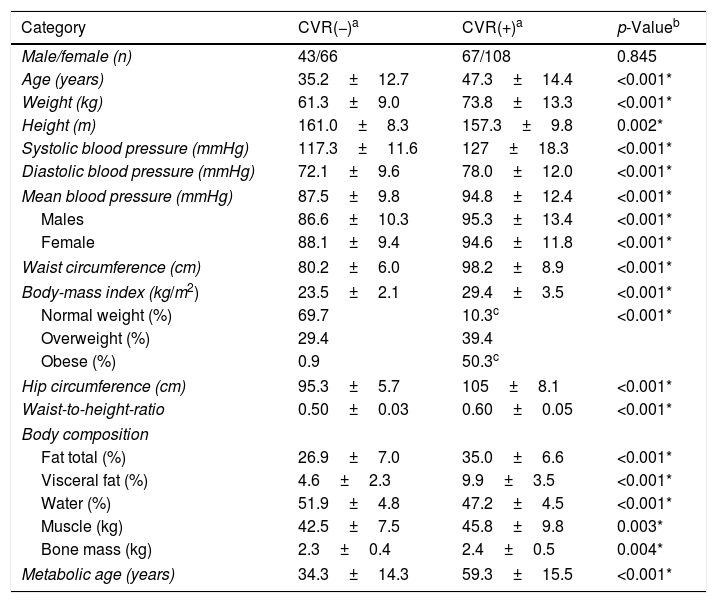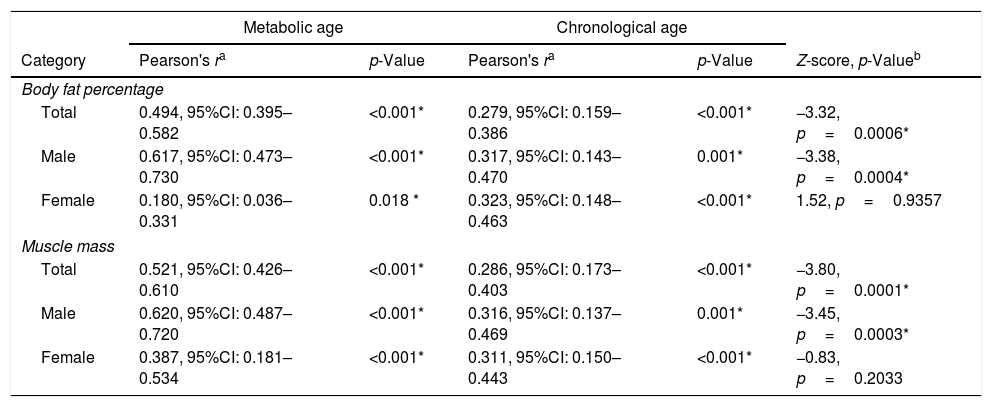Chronological age confers an increased risk for cardiovascular disease; however, chronological age does not reflect the subject's current health status. Therefore, we assessed whether Metabolic age (Met-age), based on free fat mass, is a predictor of cardiovascular risk (CVR).
MethodsSubjects attending either IMSS UMF-2 or CUSC-1 were asked to participate. CVR was assessed using the waist-to-height ratio (WHtR), whereas Met-age was determined using the TANITA bio-analyser (model: BC-545F Fitscan). The strengthen of association was determined by calculating Pearson's r and predictability was determined by the area-under-a-receiver-operating characteristic curve (AUC).
Results284 subjects participated in this study, of which 61.6% had increased CVR. As expected, the chronological age was significantly higher in the CVR(+) group than the CVR(−) group (47.3±14.4 v. 35.2±12.7, respectively, p<.001) as well as Met-age (59.3±15.5 v. 34.3±14.3, respectively, p<.001). There was a strong association between WHtR and Met-age (r=.720, p<.001) and a moderate association for chronological age (r=.407 p<.001); however, the correlation between WHtR and Met-age was significantly better than chronological age (Z=−5.91, p<.01). Met-age was a good predictor of CVR (AUC=.88, 95%CI: .83–.92, p<.001), whereas chronological age was a fair predictor (AUC=.72, 95%CI: .66–.78, p<.001). However, Met-age showed a higher discriminatory capacity for CVR than chronological age (z=−4.597, p<.001).
ConclusionsHere, we determined that Met-age correlated with a CVR index, WHtR, and was able to predict subjects with increased CVR better than chronological age.
La edad cronológica confiere un mayor riesgo a la enfermedad cardiovascular; sin embargo, la edad cronológica no refleja el estado de salud actual del individuo. Por lo tanto, evaluamos si la edad metabólica (Met-age), basada en masa de grasa libre, es un factor predictivo del riesgo cardiovascular (RCV).
MétodosSe solicitó su participación a individuos que asistían a IMSS UMF-2 o CUSC-1. Se evaluó el RCV utilizando el índice cintura-altura (ICA), mientras que Met-age se determinó utilizando el bioanalizador TANITA (modelo: Bc-545F Fitscan). La fuerza de asociación se determinó calculando la r de Pearson, y la predictibilidad se determinó mediante el índice de área bajo la curva (AUC).
ResultadosDoscientos ochenta y cuatro sujetos participaron en este estudio, de los cuales el 61,6% reflejó un aumento del RCV. Como se esperaba, la edad cronológica fue significativamente mayor en el grupo del RCV+ que en el grupo del RCV− (47,3±14,4 vs. 35,2±12,7, respectivamente; p<0,001), así como en Met-age (59,3±15,5 vs. 34,3±14,3, respectivamente; p <0,001). Se produjo una fuerte asociación entre el ICA y la Met-age (r=0,720; p<0,001) y una asociación moderada con la edad cronológica (r=0,407; p<0,001); sin embargo, la correlación entre el ICA y la Met-age fue significativamente mejor que la edad cronológica (Z=−5,91; p<0,01). La Met-age fue un buen predictor del RCV (AUC=0,88, IC 95%: 0,83-0,92; p<0,001), mientras que la edad cronológica fue un factor predictivo moderado (AUC=0,72; IC 95%: 0,66-0,78; p<0,001). Sin embargo, la Met-age mostró una mayor capacidad discriminatoria para identificar el RCV que la edad cronológica (z=−4,597; p<0,001).
ConclusionesEn este estudio determinamos que la Met-age se correlacionó con el índice ICA del RCV, y fue capaz de predecir sujetos con RCV mejor que la edad cronológica.












